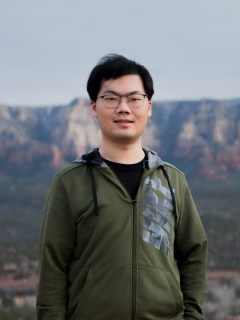Lower rainfall and higher temperatures have created ideal conditions to exacerbate Arizona’s longstanding drought. Entering 2022, more than half of the state remains in severe drought status and an additional 10% is enduring extreme drought. So, what is the impact of the Arizona drought?
READ ALSO: Here’s how Arizona developers balance growth with protecting water assets
These conditions — including the drop in levels at crucial water sources such as Lake Mead and the Colorado River — drive the research of doctoral student Zhaocheng Wang, who is studying hydrosystems engineering in the School of Sustainable Engineering and the Built Environment, one of the seven Ira A. Fulton Schools of Engineering at Arizona State University.
Wang’s dissertation research focuses on combining modeling tools and earth observation products to better understand hydrological processes in the Southwestern United States. He has dedicated part of his dissertation research to determine the impacts the Colorado River drought will have on the people who live and work in Arizona.

“Water is a scarce and valuable resource for us living in the desert, especially under the impact of climate change,” Wang says. “A better understanding of hydrological processes can help us to better use and protect this resource and live a more sustainable lifestyle in preparation for a hotter and drier future.”
Wang was one of four students from across the U.S. and Mexico named as a 2022 Babbitt Center Dissertation Fellow by the Lincoln Institute’s Babbitt Center for Land and Water Policy, a leading nonprofit foundation supporting research and preservation of the Colorado River Basin.
The Babbitt Center Dissertation Fellowship recognizes the work of outstanding doctoral students, provides a $10,000 stipend and allows access to a wealth of resources including collaboration with other researchers to support their efforts.
“Zhaocheng Wang has become a leading-edge researcher in the application of remote sensing and modeling for water resources applications,” says Enrique Vivoni, the Fulton Professor of Hydrosystems Engineering in the School of Sustainable Engineering and the Built Environment and doctoral adviser to Wang. “His PhD work spans a broad range of topics, from quantifying water in dryland rivers to creating scenarios of future water use in cities and agricultural areas. And for each, he has demonstrated a keen awareness of novel, impactful outcomes.”
Wang started his academic career in China at Hunan University. While there, he completed a study abroad year at ASU. He says he had the opportunity to take a course in hydrology with Associate Professor Giuseppe Mascaro and was encouraged by Associate Professor Zhihua Wang to pursue a graduate degree and conduct research landing him back at ASU after completing his undergraduate studies.
“I think the hydrosystems engineering program, which consists of a group of faculties and students with diverse backgrounds and expertise, really created a dynamic and enthusiastic environment suitable for collaborative research drawing me back,” Wang says.
In addition to the academic environment at ASU, Wang says Arizona’s drought conditions present unique opportunities for not only research but also application of what hydrosystems engineering students learn about the physical environment.
“The unprecedented current drought in the Southwestern United States has triggered a Tier 1 water shortage,” Wang says. “As a result, the water delivered to Arizona from the Colorado River will be cut by 30% in 2022. Farmers in central Arizona — mostly in Pinal County — who have lower priority in water rights will have less water to use.”
He says farmers will have to make big changes to how they choose to use the water they are allotted, such as fallowing crop fields or choosing more drought-tolerant crops. Wang says it is also possible that farmers will use more groundwater to compensate for the cut from the Colorado River. These decisions not only have an impact on farmers but employment in rural communities and the local economy, as well as food security in the Phoenix metropolitan area.
Wang’s winning proposal for the Babbitt Dissertation Fellowship — “Monitoring Cropland Response to Water Shortage Using Remote Sensing Observations on a Cloud-Computing Platform” — focuses on integrated land and water management using a set of remote-sensing observations derived from satellites. He plans to utilize satellite imagery from Planet Labs, which are obtained from a constellation of CubeSats, or shoebox-size satellites, to map active croplands and derive acreage of different crop types.
“This is important for us to understand the farmers’ choices under the conditions of a water shortage,” Wang says.
The second part of the project is to simulate the amount of irrigation water used on those crops. Combined with records of water delivered from the Colorado River, this project has the potential to map groundwater use under the shortage.
“It is important to be concerned about the drought and understand the potential impacts of drought on our daily lives, such as more wildfires, less local food and fewer recreational activities due to low water levels in lakes,” Wang says. “The drought is getting worse and propagates faster and wider under the effects of climate change. We need to be prepared.”
He says he hopes to present his research to local water management communities and solicit their feedback to develop the next phase of tools for more sustainable water resource management.
“I want to thank my adviser, Professor Enrique Vivoni, for his guidance and encouragement, especially in the process of writing this proposal,” Wang says. “Throughout my PhD, he spared no effort to foster my ability to think independently by encouraging me to write research proposals, including the one that won the Babbitt Fellowship.”





